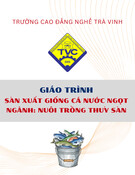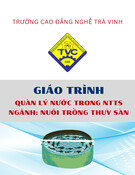
196
HNUE JOURNAL OF SCIENCE
Natural Sciences 2024, Volume 69, Issue 3, pp. 196-208
This paper is available online at http://hnuejs.edu.vn/ns
DOI: 10.18173/2354-1059.2024-0049
EVIDENCE OF MICROPLASTICS IN AGRICULTURAL WATER SYSTEMS
OF NINH BINH PROVINCE, NORTHERN VIETNAM
Cao Thi Thanh Nga1,2,*, Le Thi Phuong Quynh2,3, Nguyen Thi My4
and Duong Thi Thuy2,4
1Institute of Human Geography, Vietnam Academy of Social Science,
Hanoi city, Vietnam
2Graduate University of Science and Technology, Vietnam Academy of Science and
Technology (VAST), Hanoi city, Vietnam
3Institute of Natural Products Chemistry, VAST, Hanoi city, Vietnam
4Institute of Science and Technology for Energy and Environment, VAST,
Hanoi city, Vietnam
*Corresponding author: Cao Thi Thanh Nga, e-mail: caothithanhnga@gmail.com
Received October 4, 2024. Revised October 26, 2024. Accepted October 31, 2024.
Abstract. Microplastics are regarded as an emerging threat to water and other
environments. The increasing use of plastics in agricultural cultivation has led to
higher risks and more dangerous pollution of agricultural water. However,
microplastics in agricultural water in Vietnam have neither been studied nor
documented in any publication. To provide initial scientific evidence of
microplastics in agricultural water in the country, we conducted a case study in Kim
Son district, Ninh Binh province. Water samples were randomly collected from 15
representative sites within the canal systems of the study area. Our study results
indicated that the agricultural water in the study area was polluted by microplastics,
which vary considerably in all size, shape, and color aspects. The average
concentration of microplastics found in the examined water was 491 ± 259
particles/m³, with detected microplastic sizes ranging from 302 to 4,593 µm. Among
these, microplastics sized between 300 and 1,000 µm were the most dominant,
accounting for 61.8% of the total detected microplastics. In terms of shape, 94.5%
of the detected microplastics were fibers, present at all 15 study sites, while only
5.5% were fragments, found at just seven sites. The microplastics were also highly
diverse in color, with white being the most common and densely present in every
analyzed water sample. The results of the present study provide the first scientific
evidence of microplastic occurrence in agricultural water within the study area and
can serve as a crucial basis for comprehensive research and effective management
of plastic products in the future.
Keywords: agriculture, microplastics, pollution, Vietnam, water.

Evidence of microplastics in agricultural water systems of Ninh Binh province, northern Vietnam
197
1. Introduction
Microplastics refer to small plastic fragments less than 5 mm in size [1]. A global review
revealed that plastic production has rapidly increased over the past decades, from 2 million
tons in 1950 to 348 million tons in 2017 and 368 million tons in 2019 [2]. Between 1950
and 2021, the total volume of plastic produced was approximately 8.3 billion tons, and it is
estimated to double by 2040 [3]. Notably, the growth in plastic production has outpaced that
of any other goods [2]. Due to their small size, lightweight nature, and ease of movement in
the environment, microplastics can spread widely, posing health risks to both microorganisms
and humans. They are found in almost all ecosystems, including soil, water, air, and
biological organisms. Microplastics can originate from various sources, including daily
activities, agricultural cultivation, industrial processes, and other sectors.
Agricultural cultivation and production have emerged as sources of microplastics
entering water and sediment environments [4]. Plastic products are widely and extensively
used in agriculture due to the versatility and diversity of plastic polymers, their beneficial
physical properties, and their affordability for farmers and others. Many greenhouses are
covered with plastic roofs to enhance crop productivity, while plastic films are also employed
in livestock farming. Additionally, bags and packaging for pesticides and herbicides are made
of plastic. It is estimated that the cultivation and livestock sectors use a large amount of
plastic, approximately 10 million tons per year, followed by fisheries and aquatic aquaculture
with 2.1 million tons annually. The volume of plastic used globally in agricultural cultivation
for greenhouses, coatings, and composting films is projected to increase by 50%, from 6.1
million tons in 2018 to 9.5 million tons by 2030 [5]. While these plastic products benefit
farmers and help conserve natural resources, they also pose critical risks. The use of plastic
in agriculture has contributed to increasing microplastic pollution, which negatively impacts
both human health and ecosystems.
In Vietnam, microplastics have been studied in several environments [6]-[16]. However,
to our knowledge, all previous studies on microplastics in the country have focused solely on
the surface waters of rivers, lakes, marine areas, and soil environments. As a result,
microplastics in agricultural water have received little attention from both scientists and
authorities. In fact, microplastics represent a growing threat as a form of pollution in
agricultural ecosystems [17]. Notably, Vietnam is ranked among the top five rice-producing
countries in the world and is home to two major river deltas: the Red River Delta and the
Mekong Delta. To enhance our understanding of microplastics in agricultural water, we
conducted a case study in the agricultural area of Kim Son District, Ninh Binh Province,
within the Red River Delta. This district covers an area of 239.78 km² and is home to over
188,000 people as of 2023. Of these, 173,173 residents, accounting for approximately 92.1%
of the district’s population, are farmers [18]. To comprehensively develop the district’s
agricultural cultivation, livestock, and aquaculture, the "Agricultural Economic Development
for the Period 2022–2025" project has been implemented. As a result, agricultural
productivity has expressively increased, reaching up to 196 million VND per hectare,
compared to the provincial average of 46 million VND per hectare [19]. While agricultural
development has contributed to economic growth and improved incomes for local people, it
has also heightened the risk of plastic waste entering the environment. Despite this growing
concern, microplastic pollution in agricultural water in Kim Son district, and indeed in other

Cao TTN*, Le TPQ, Nguyen TM & Duong TT
198
localities across Vietnam, has received little scientific attention until now. Recognizing the
risks posed by microplastics in the agricultural environment, we present scientific evidence
of microplastic contamination in agricultural water downstream of the Day River. This case
study offers a foundation for future considerations and management by scientists and
authorities, from regional to international levels.
2. Content
2.1. Materials and methods
2.1.1. Study area
To assess the risks of microplastic pollution in agricultural water, we selected the
canal systems throughout Kim Son district, Ninh Binh province, for random sample
collection during this study. The study areas encompass canal systems in Binh Minh town
and Con Thoi commune within the Kim Son district. Water samples were collected from
15 sites along the canals. Eight of these sites are located in Binh Minh town, while the
remaining sites are in Con Thoi commune. The coordinates and surrounding habitat of
the study sites are provided in Table 1.
Table 1. Study sites for agricultural water sampling in Kim Son district, Ninh Binh
province, northern Vietnam
Study site ID
(co-ordinates)
Surrounding habitats
KS1
(106°3’43’’N; 19°58’27”E)
Canal system supplying water for rice cultivation and
duck farming in Binh Minh town.
KS2
(106°3’42”N; 19°58’27”E)
Canal system supplying water for rice cultivation and
duck farming in Binh Minh town.
KS3
(106°3’44”N; 19°58’28”E)
Canal system supplying water for rice cultivation and
duck farming in Binh Minh town.
KS4
(106°3’46”N; 19°58’30”E)
Canal system supplying water for rice cultivation and
duck farming in Binh Minh town.
KS5
(106°3’47”N; 19°58’30”E)
Canal system supplying water for rice cultivation and
duck farming in Binh Minh town.
KS6
(106°3’51”N; 19°58’33”E)
Canal system supplying water for rice cultivation and
duck farming in Binh Minh town.
KS7
(106°3’58”N; 19°58’39”E)
Canal system supplying water for rice cultivation and
duck farming in Binh Minh town.
KS8
(106°4’48”N; 19°58’43”E)
Canal system supplying water for rice cultivation and
duck farming in Binh Minh town.
KS9
(106°4’48”N; 19°58’57”E)
Canal system supplying water for rice cultivation in Con
Thoi commune.
KS10
(106°4’48”N; 19°59’7”E)
Canal system supplying water for rice cultivation in Con
Thoi commune.
KS11
(106°4’48”N; 19°59’11”E)
Canal system supplying water for rice cultivation in Con
Thoi commune.

Evidence of microplastics in agricultural water systems of Ninh Binh province, northern Vietnam
199
KS12
(106°4’48”N; 19°59’18”E)
Canal system supplying water for rice cultivation in Con
Thoi commune.
KS13
(106°4’48”N; 19°59’17”E)
Canal system supplying water for rice cultivation in Con
Thoi commune.
KS14
(106°4’48”N; 19°59’26”E)
Canal system supplying water for rice cultivation in Con
Thoi commune.
KS15
(106°4’48”N; 19°59’34”E)
Canal system supplying water for rice cultivation in Con
Thoi commune.
2.1.2. Sampling and analysis
A field trip for collecting agricultural water was carried out throughout the study sites
in the rainy season in June 2024, after the rice harvest, when water levels in the canal
system are typically moderate. At each study site, we collected 50 liters of agricultural
water from the canal systems and filtered it through a specialized filter mesh with a pore
size of 80 µm. The objects retained on the filter mesh after filtering each 50 liters of water
were regarded as a sample, which was then transferred to a glass vial and stored at 4°C
for analysis. All samples were analyzed following Strady et al. (2021) [20] with
appropriate adjustments for practical application. Each sample was first filtered through
a filter with a mesh size of 5mm x 5mm to separate the larger size portions. The filtered
water with objects including microplastics smaller than 5000 μm in size was retained in
a 500ml glass bottle, then analyzed using Sodium Dodecyl Sulfate (SDS, Merck®) at
50°C for 24 hours, biozyme SE (protease and amylase) and biozyme F (lipase) at 40°C
for 48 hours and hydrogen peroxide (H2O2 30%, Merck®) at 40°C for 48 hours. After the
analytical processes using the aforementioned chemicals, each sample was further filtered
through a mesh filter with a size of 250 µm. Objects smaller than 250 µm were removed,
while all objects larger than 250 µm were transferred to a clean glass beaker. A saturated
NaCl solution was used for collecting microplastics. This process was repeated at least
five times to ensure the recovery of all microplastics in each sample. Finally, the solution
containing microplastics was filtered through GF/A filter paper (pore size 1.6 µm) using
a glass filter. The filter paper containing the microplastics was placed in a sterile glass
petri dish and examined under a Leica S9 microscope connected to a computer. The size,
shape, and color of the microplastics were observed and recorded using LAS® software.
In this study, following GESAMP's recommendations, we focused solely on
microplastics with a minimum length of 300 µm and plastic fragments with a minimum
area of 45,000 µm² or larger.
2.2. Results and discussion
2.2.1. Microplastic density in agricultural water at the study sites
Microplastics were detected at every study site within the canal systems supplying
water to agricultural areas in Kim Son District, Ninh Binh Province (Figure 1).
Microplastic density varied widely among the study sites (Figure 1). Of the 15 sites,
the highest microplastic concentration was observed at KS1, with 1,120 particles per
cubic meter (m³), while the lowest concentrations were recorded at KS8 and KS15, with
240 particles/m³. The microplastic densities at the remaining sites ranged from 260 to 920
particles/m³. The detected microplastic density at each study site depends on factors such as

Cao TTN*, Le TPQ, Nguyen TM & Duong TT
200
plastic erosion, waste flow, and the accumulation of microplastics over time and space.
The KS1 site, located at the end of the agricultural canal system that drains into the Day
River and subsequently flows to the sea through the Cua Day estuary, showed the highest
concentration. Previous studies in other countries have highlighted similar sources of
microplastics in agricultural water. Lwanga et al. (2023) [21] indicated that the use of
compost and plastic mulch are major contributors to microplastic flow into soil and water
environments. Additionally, soil amendments such as organic fertilizers, sewage sludge,
and irrigation with wastewater often emit microplastics due to the large amounts of
synthetic polymers in containers and other materials [22].
Figure 1. Microplastic abundance in agricultural water at each study site
With an average value of 491 ± 259 particles/m³, the microplastic density at the study
sites was considerably lower than those reported in previous studies [5]. Wang et al.
(2020) recorded microplastic densities in agricultural water from livestock farms ranging
from 8,000 to 42,000 particles/m³ and in fish ponds ranging from 13,000 to 27,000
particles/m³, which are 16 and 85 times higher, respectively, than the levels found in the
present study. However, the microplastic density in the downstream areas of the Day
River is notably higher than previously reported in other rivers in Vietnam. Strady and
Nguyen (2021) [23] recorded microplastic densities of 2.3 particles/m³ in the Red River,
2.7 particles/m³ in the Han River, 3.9 particles/m³ in the Dong Nai River, and 93.7
particles/m³ in the Nhue River. Another study reported an average microplastic density
of 53.8 ± 140.7 particles/m³ in the Mekong River, with polyethylene (PE) being the most
dominant type, comprising 67% of the total microplastics found [24].
2.2.2. Microplastic sizes in the studied agricultural water
The recorded microplastic sizes at the study sites ranged between 302 and 4,593 µm,
with an average of 892 ± 198 µm (Figure 2). Among the observed and measured
microplastics, 214 particles were classified as the smallest, with sizes between 300 and
1,000 µm, accounting for 61.5% of the total observed microplastic particles. At each
study site, the proportion of these smallest particles ranged from 26.7% to 92.9% of the
total number of microplastics. Additionally, 98 particles sized between 1,000 and 2,000
µm were observed, making up 28.2% of the total particle count. Larger particles, sized
2,000-3,000 µm, 3,000-4,000 µm, and 4,000-5,000 µm, were also found but only
0
200
400
600
800
1000
1200
Microplastic abundance
(particle/m3)
Study site










![Giáo trình Sản xuất giống tôm nước lợ, mặn (Trung cấp/Cao đẳng) - Trường Cao đẳng nghề Trà Vinh [Mới nhất]](https://cdn.tailieu.vn/images/document/thumbnail/2025/20251115/kimphuong1001/135x160/76031763179346.jpg)










